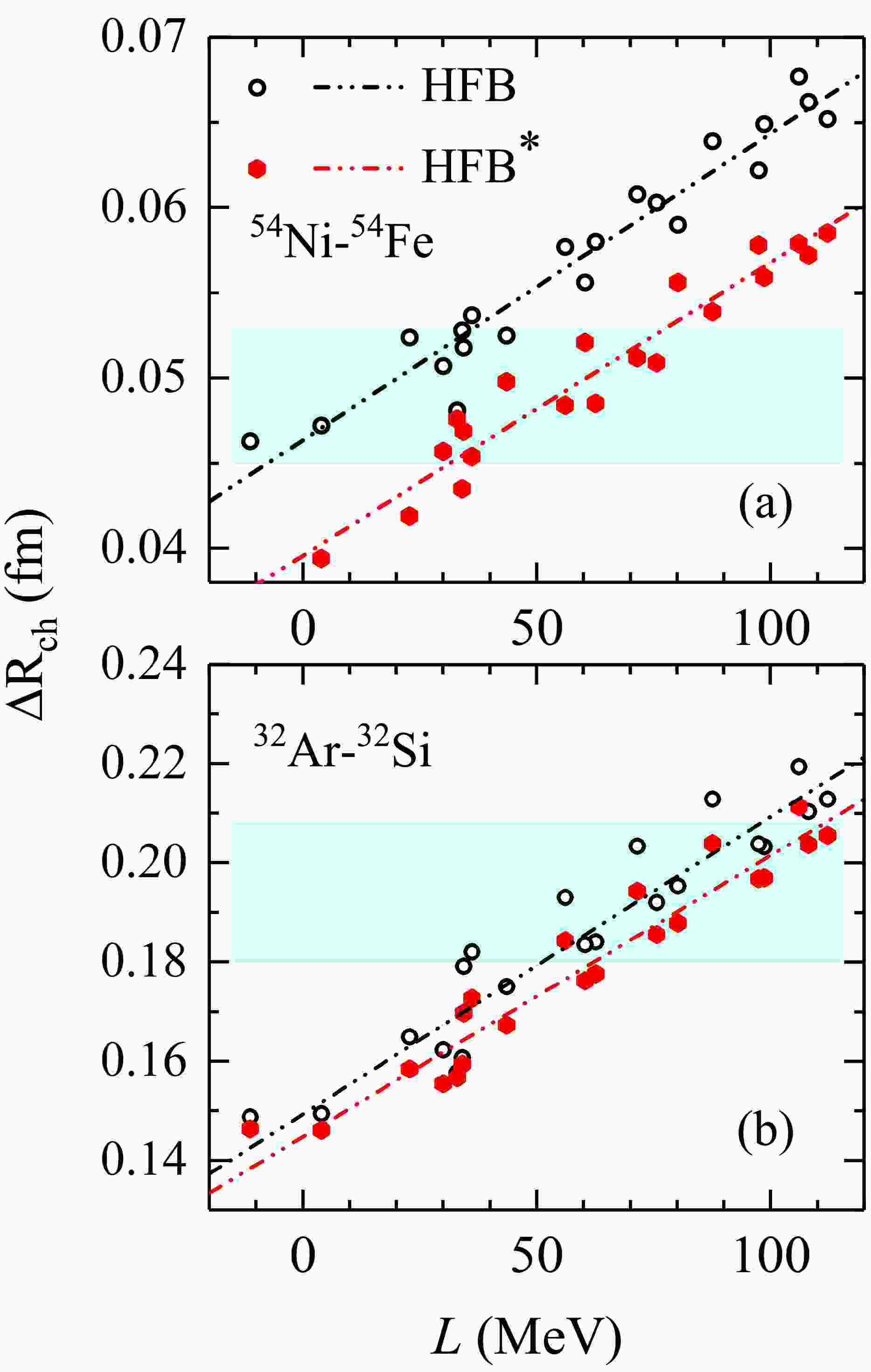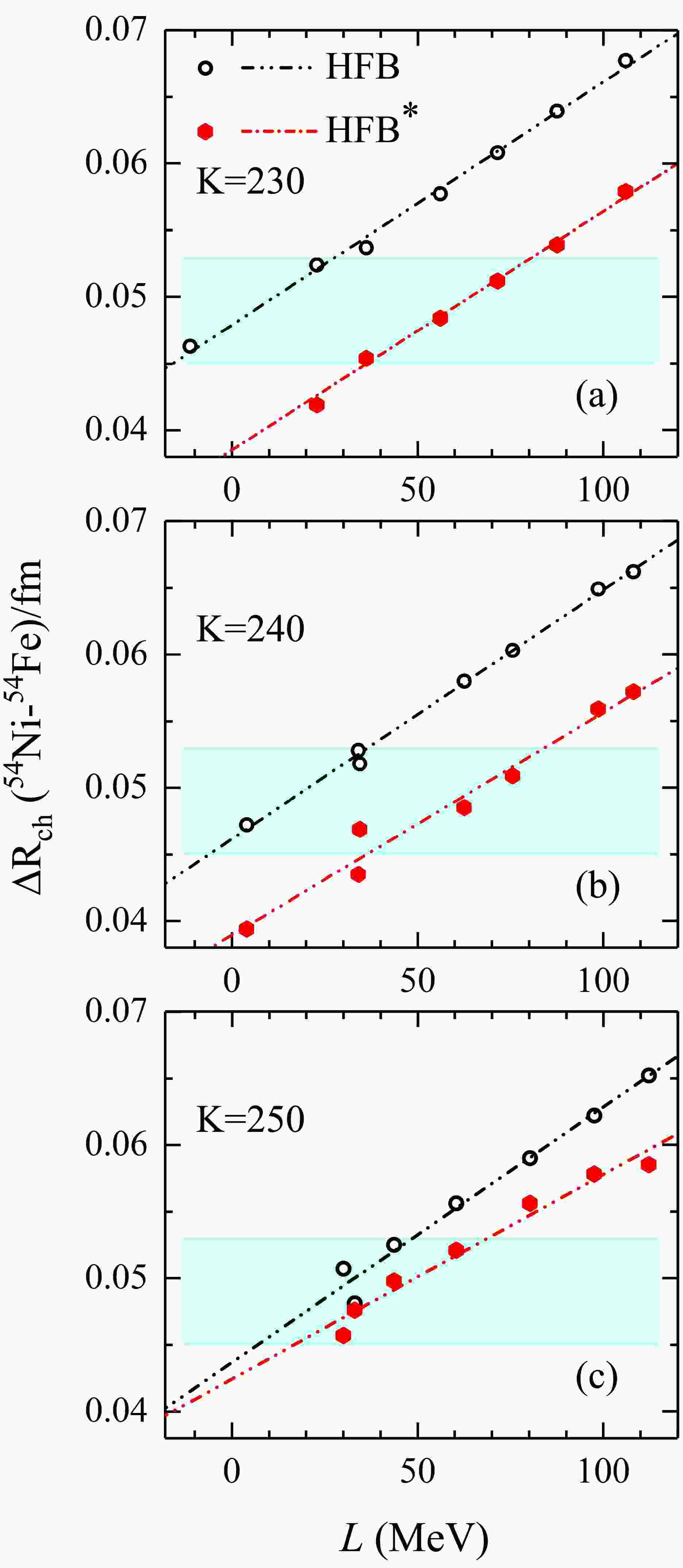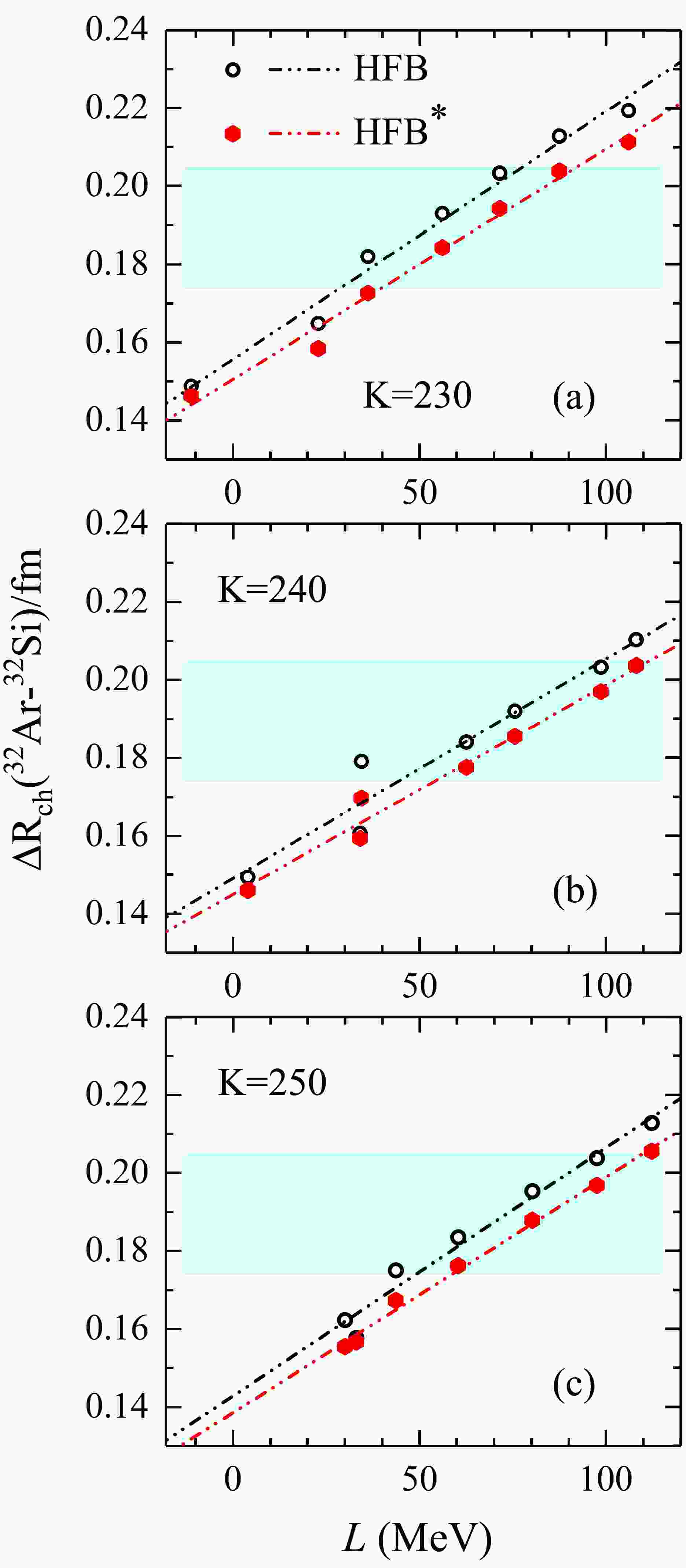-
As accurately measured quantities in terrestrial laboratories, charge radii are generally used to encode the nuclear structure phenomena, such as the shape-phase transition [1–6], shell quenching phenomena [7–13], and the odd-even staggering (OES) effects [14–19]. Precise knowledge of nuclear size plays an indispensable role in the course of nuclear physics and astrophysics [20]. Especially, charge radii difference in mirror-paired nuclei naturally defined with neutron number N and proton number Z exchanged but with the same mass number
$ A=N+Z $ is intimately associated with our understanding of the fundamental interactions. The highly linear correlation between the difference of charge radii of mirror partner nuclei ($ \Delta{R_{{\rm{ch}}}} $ ) and the symmetry energy slope (L) was firstly proposed in Ref. [21]. Then more researches have verified that the charge radii differences of mirror-pair nuclei are linearly correlated with the slope parameter of symmetry energy [22–31].Owing to the advanced techniques in experiments, much more data on charge radii of nuclei far away from the β-stability line have been accumulated [32, 33]. Generally, nucleus can be regarded as the incompressible liquid-drop, and its size can be ruled by the
$ A^{1/3} $ or$ Z^{1/3} $ law [34–36]. However, the microscopic aspects cannot be featured yet, such as the information about proton density distributions and single particle levels. The relativistic mean field theory [37, 38] and non-relativistic Skyrme Hartree-Fock-Bogoliubov (HFB) approach [39, 40] can also be used to describe the systematical evolution of nuclear charge radii as well, but the local variations of nuclear charge radii cannot be captured adequately along a long isotopic chain.Fine structures of nuclear charge radii can be influenced by various underlying mechanisms [41]. With considering the density gradient terms in its pairing interactions part, the discontinuous behavior of charge radii can be described well [42]. Shown in Refs. [27, 43], the correlations between the charge radii differences of mirror-pair nuclei and the slope parameter of symmetry energy are reduced by the pairing effects. Meanwhile, the shape deformation can also have an influence on determining the local variations of nuclear charge radii [1, 6]. As mentioned in Ref. [30], the quadrupole deformation correction has been taken into account in describing the charge radii difference of 32Ar-32Si, but the influence coming from shape deformation can almost be negligible. Besides, recent studies suggest that the compression modulus of finite nuclei cannot be ignored in ascertaining the slope parameter of symmetry energy [43, 44].
The short-range correlations between neutrons and protons have an influence on determining the charge density distributions around the Fermi surface [45–47]. This means that neutron-proton correlations should be considered appropriately in describing the bulk properties of finite nuclei [48, 49]. Meanwhile, a strong coupling between neutron- and proton-pairing correlations (being α-clusters) [50] or a residual effective four-body force [51] plays an indispensable role in describing the local variations of the nuclear charge radii. Based on the relativistic mean-field model, a novel ansatz derived from the neutron- and proton-pairs condensation around the Fermi surface has been incorporated into the root-mean-square (rms) charge radii formula [52]. This recently developed approach can reproduce the systematic evolution of nuclear charge radii including those the corresponding OES phenomena and shell closure effects [53–56]. Furthermore, this suggests that the correlation between the neutron- and proton-pairs condensation around the Fermi surface actually plays an indispensable role in describing the systematic trend of changes of nuclear charge radii.
As demonstrated above, the proton density distributions in mirror nuclei can provide an alternative access to ascertain the equation of state of isospin asymmetric nuclear matter. It is also worth noting that the influence of neutron-pairs condensation on determining the charge radii differences of mirror-paired nuclei are hardly found in the existing literatures. Therefore, the influences of neutron-pairs condensation on the determination of the charge radii differences should also be investigated based on the Skyrme EDFs. In our calculations, the spherical Hartree-Fock-Bogoliubov (HFB) framework is employed and the differential mean-square charge radii of Ni isotopes are further used to test the validity of this developed model. Moreover, the charge radii differences of mirror-pair nuclei 32Ar-32Si and 54Ni-54Fe are also applied to analyze the correlation between the charge radii difference of mirror partner nuclei and the nuclear symmetry energy slope.
The outline of the present paper is the following. In Section II, the theoretical framework is very briefly presented. In Section III, the numerical results and discussion are provided. Finally, a summary together with some perspectives are given in Section IV.
-
The Skyrme density functional has made considerable success in describing various physical phenomena [39, 40, 57–59]. In our calculations, the Skyrme-like effective interaction has been recalled as follows [60, 61],
$ \begin{aligned}[b] V({\bf{r}}_{1},{\bf{r}}_{2}) =\; & t_{0}(1+x_{0}{\bf{P}}_{\sigma})\delta({\bf{r}})\\ &+\frac{1}{2}t_{1}(1+x_{1}{\bf{P}}_{\sigma})\left[{\bf{P}}'^{2}\delta({\bf{r}})+\delta({\bf{r}}){\bf{P}}^{2}\right]\\ &+t_{2}(1+x_{2}{\bf{P}}_{\sigma}){\bf{P}}'\cdot\delta({\bf{r}}){\bf{P}}\\ &+\frac{1}{6}t_{3}(1+x_{3}{\bf{P}}_{\sigma})[\rho({\bf{R}})]^{\alpha}\delta({\bf{r}})\\ &+{\rm{i}}W_{0}{\bf{\sigma}}\cdot\left[{\bf{P}}'\times\delta({\bf{r}}){\bf{P}}\right]. \end{aligned} $

(1) Here,
$ {\bf{r}}={\bf{r}}_{1}-{\bf{r}}_{2} $ and$ {\bf{R}}=({\bf{r}}_{1}+{\bf{r}}_{2})/2 $ are naturally related to the positions of two nucleons$ {\bf{r}}_{1} $ and$ {\bf{r}}_{2} $ ,$ {\bf{P}}=(\nabla_{1}-\nabla_{2})/2{\rm{i}} $ represents the relative momentum operator acting on the right and the corresponding counterpart$ {\bf{P'}}=-(\nabla'_{1}-\nabla'_{2})/2{\rm{i}} $ characterizes its complex conjugate acting on the left, and$ {\bf{P_{\sigma}}}=(1+\vec{\sigma}_{1}\cdot\vec{\sigma}_{2})/2 $ represents the spin exchange operator that be used to dominate the relative strength of the$ S=0 $ and$ S=1 $ channels for a given term in the two-body interactions, with$ \vec{\sigma}_{1(2)} $ being the Pauli matrices. The last term features the spin-orbit force, in which$ \sigma=\vec{\sigma}_{1}+\vec{\sigma}_{2} $ . The quantities α,$ t_{i} $ ,$ x_{i} $ ($ i=0 $ -3), and$ W_{0} $ represent the parameters of the effective forces used in this work.The pairing correlations can be generally treated either by the BCS method or by the Bogoliubov transformation [37, 39, 40, 62–64]. In this work, the Bogoliubov transformation is used to treat the pairing correlations. The density-dependent zero-range pairing force is employed as follows [65, 66],
$ V_{{\rm{pair}}}({\bf{r}}_{1},{\bf{r}}_{2})=V_{0}\left[1-\eta\left(\frac{\rho({\bf{r}})}{\rho_{0}}\right)\right]\delta({\bf{r}}_{1}-{\bf{r}}_{2}). $

(2) Here,
$ \rho({\bf{r}}) $ is the baryon density distribution in coordinate space and$ \rho_{0}=0.16\; {\rm{fm}}^{-3} $ represents the nuclear saturation density. Generally, the values of η are taken as$ 0.0 $ ,$ 0.5 $ , or$ 1.0 $ for volume-, mixed-, or surface-type pairing interactions, respectively. As mentioned in Refs. [27, 43], the pairing correlations have an influence on determining the correlation between the charge radii difference of mirror-pair nuclei and the slope parameter of symmetry energy. Therefore, the mixed-type pairing force is chosen in our calculations. The quantity$ V_{0} $ is adjusted by calibrating the empirical energy gaps with three-point formula [65, 67]. The single-particle energy levels and wave functions of the constituent nucleons can be obtained by solving the HFB equations with the self-consistent iteration method [68].The range of the proton matter distributions can be deduced from the wave functions of the constituent protons. The quantity of nuclear charge radius (
$ R_{{\rm{ch}}} $ ) can be defined as the root-mean-square radius of its proton distribution, which can be calculated through the following expression (in units of fm2) [55],$ R_{{\rm{ch}}}^{2}=\langle{r_{{\rm{p}}}^{2}}\rangle+0.7056+\frac{a_{0}}{\sqrt{A}}\Delta{\cal{D}}+\frac{\delta}{\sqrt{A}}. $

(3) The first term
$ \langle{r_{{\rm{p}}}^{2}}\rangle $ represents the charge density distributions of point-like protons and the second one is attributed to the finite size of protons [69]. For the third term, the expression$ \Delta{\cal{D}} $ is defined as$ \Delta{\cal{D}}=|{\cal{D}}_{n}-{\cal{D}}_{p}| $ . The quantity of$ {\cal{D}}_{n} $ ($ {\cal{D}}_{p} $ ) is recalled as follows,$ {\cal{D}}_{n,p}=\sum\limits_{k>0}^{n,p} u_k{v}_k, $

(4) where
$ v_k^{n,p} $ is the amplitude of the occupation probability of the kth quasi-particle orbital for neutron or proton at the canonical basis, and$ u_k^2={1-v_k^2} $ . It is also mentioned that the quantity of$ {\cal{D}}_{n,p} $ can be used to measure the Cooper pairs condensation around the Fermi surface [70, 71]. The expression of$ \Delta{\cal{D}} $ is used to measure the neutron- and proton-pairs correlation around the Fermi surface [17, 52]. The parameter set$ a_{0}=0.561 $ is adjusted by reproducing the parabolic-like shape and odd-even oscillation behaviors in the charge radii of K and Ca isotopes [55]. The last term is considering the correlation between the simultaneously unpaired neutron and proton. For mirror pair nuclei, the difference in charge radii ($ \Delta{R_{{\rm{ch}}}} $ ) can be obtained through the formula Eq. (3). Actually, the last term is invalid due to the time-reversal symmetry is assumed in this work, namely restricting ourselves to even-even nuclei. -
The influence of neutron-proton correlation deduced from the neutron- and proton-pairs condensation around the Fermi surface has been incorporated into the rms charge radii formula based on the relativistic EDFs [52–56]. However, the corresponding discussion is hardly found in the Skyrme EDFs. Firstly, the differential mean-square charge radii of Ni isotopes are employed to review the validity of this theoretical model based on the Skyrme density functional model. The mixed-type pairing interaction is used and the pairing strength is chosen to
$ V_{0}=370.2 $ MeV fm3 by adjusting the empirical energy gap along the Ni isotopes. This is in accord with Ref. [43]. Two pairs of mirror nuclei 32Ar-32Si and 54Ni-54Fe are used to inspect the influence of neutron-proton correlations on determining the charge radii difference of the corresponding mirror-pair nuclei. For the convenience of our discussion, the results obtained by Eq. (3) are labeled by HFB*. While the results obtained by the approach without considering the influence coming from the neutron- and proton-pairs condensation are marked by HFB.Shell closure effects of charge radii are generally observed throughout the whole nuclear chart [32, 33]. As mentioned in Ref. [72], Skyrme EDFs cannot describe the shell closure effect in nuclear charge radii well. Recently developed RMF(BCS)* model can characterize the discontinuous behaviors of nuclear charge radii, especially the shell quenching phenomena [55]. Therefore, it is worthwhile to use this method to ascertain the slope parameter of symmetry energy. The parameter sets of the effective forces used in this work and the corresponding values of the bulk properties of symmetric nuclear matter are shown explicitly in Table 1. Under the specific incompressibility coefficients K, the slope parameter L and symmetry energy
$ E_{{\rm{sys}}} $ at saturation density$ \rho_{0} $ cover long range. It should be mentioned that the correlation between the charge radii differences of mirror partner nuclei and the slope parameter of symmetry energy can be influenced by the incompressibility coefficients of symmetry nuclear matter [43, 44]. Meanwhile, giant monopole resonances provide the value of the isoscalar incompressibility$ K=230\pm10 $ MeV [73, 74]. Thus the parameter sets s3032 and s4032 classified by the almost similar slope parameters but different incompressibility coefficients are chosen in describing the differential charge radii of Ni isotopes.K (MeV) Sets L (MeV) $ E_{{\rm{sys}}} $ (MeV)

$ K\approx230 $ MeV

s3028 $ -11.2262 $ 

28 s3030 22.8715 30 s3032 36.2246 32 s3034 56.1442 34 s3036 71.5428 36 s3038 87.6155 38 s3040 106.0862 40 $ K\approx240 $ MeV

s4028 3.9774 28 s4030 34.0735 30 s4032 34.4283 32 s4034 62.5884 34 s4036 75.6679 36 s4038 98.6522 38 s4040 108.1741 40 $ K\approx250 $ MeV

s5028 33.0037 28 s5030 30.0248 30 s5032 43.5871 32 s5034 60.3202 34 s5036 80.1762 36 s5038 97.4925 38 s5040 112.2079 40 Table 1. Saturation properties of the Skyrme parametrization sets used in this work [43], such as the incompressibility coefficients K (MeV), slope parameter L (MeV) and symmetry energy
$ E_{{\rm{sys}}} $ (MeV) at saturation density$ \rho_{0} $ (fm-3), are shown.Charge radii of Ni isotopes have been detected accurately through collinear laser spectroscopy approach [24, 72, 75]. The extracted results suggest that the shell quenching phenomenon in charge radii can be observed significantly around the fully filled
$ N=28 $ shell. Moreover, across the neutron number$ N=28 $ , the trend of changes in the charge radii is similar to the Ca isotopic chain. Actually, the systematic evolution of nuclear charge radii across the$ N=28 $ shows the similar trend from K to Zn isotopic chains, namely that is almost independent of the atomic number [55, 76].As shown in Fig. 1, the differential charge radii of Ni isotopes with respect to reference nucleus 56Ni are depicted by the HFB and HFB* methods with the effective forces s3032 and s4032, respectively. It can be seen that HFB* model can reproduce the trend of changes of charge radii across the
$ N=28 $ shell closure along Ni isotopic chain as shown in Fig. 1 (a). Meanwhile, the decreased trend of charge radii from 54Ni to 56Ni can be reproduced as well. This leads to the significantly observed kink phenomenon at the neutron number$ N=28 $ . Here, it can be found that the values of charge radii for isotopes 60,62Ni are slightly underestimated for the s3032 effective force. In contrast to HFB* model, the differential charge radii of Ni isotopes cannot be reproduced by the HFB model. Particularly, the rapid increase of charge radii cannot be reproduced well across the fully filled$ N=28 $ shell. The same scenario can also be encountered around$ N=50 $ where the HFB model cannot represent the shrinking trend of charge radii. By contrast, shell quenching phenomenon in charge radii of Ni isotopes could be predicted at the neutron number$ N=50 $ through the HFB* model.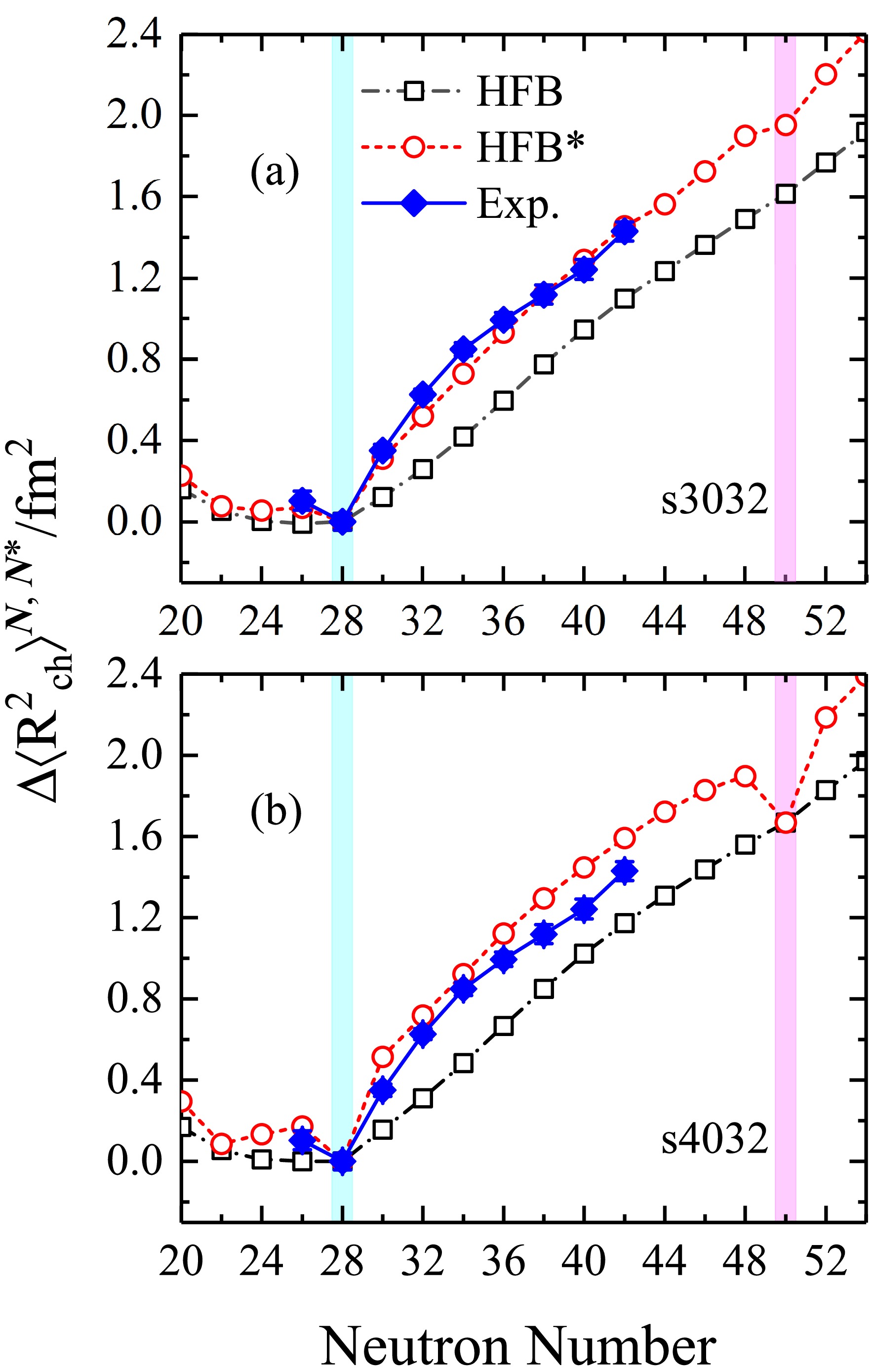
Figure 1. (Color online) Mean-square charge radii differences of the even-even Ni isotopes relative to the 56Ni nucleus obtained by the Skyrme EDFs with the parameter sets s3032 (a) and s4032 (b) are presented for HFB (open square) and HFB* (open circle) methods. The experimental data are taken from the Refs. [24, 32, 33, 72, 75] (solid diamond). The shadowed planes mark the neutron magic numbers
$ N=28 $ (light blue) and$ N=50 $ (light pink), respectively.As is well known, the inverted parabolic-like shape of charge radii can be evidently observed between the neutron numbers
$ N=20 $ and$ N=28 $ along K and Ca isotopes [32, 33]. The inverted parabolic-like shape of charge radii along Ni isotopic chain can be obtained by the HFB* model between the neutron numbers$ N=20 $ and$ N=28 $ . However, this phenomenon cannot be represented in the HFB model. This can be found obviously that the trend of change of charge radius for 54Ni isotope cannot be reproduced well by the HFB model. Moreover, the inverted parabolic-like shape of charge radii obtained by the HFB* model can also be found between the neutron numbers$ N=28 $ and$ N=50 $ . Thus more experimental data are urgently required in future research.In Fig. 1 (b), the results obtained by the HFB and HFB* models are drawn with the effective force s4032. The shell quenching effects of charge radii at the neutron numbers
$ N=28 $ and$ N=50 $ can also be emerged from the HFB* model. However, the differential charge radii of 66,68,70Ni isotopes obtained by the HFB* model are slightly deviated from the experimental data. Here, it should be mentioned that the HFB model still underestimates the systematic trend of changes of charge radii in the Ni isotopes. Significant deviations can be found between the absolute values obtained by the effective force s3032 and experimental ones with respect to those calculated by the effective force s4032. The stability properties of finite nuclei are mostly determined by the Coulomb force and the symmetry energy. The larger symmetry energy means that more strong isospin interactions can be captured, which leads to the larger range of the charge density distributions radii [77]. In our calculations, the remarkably shrunken phenomenon of the differential charge radii at the neutron number$ N=50 $ can be obtained by the parameter set s4032 compared to the effective force s3032. This is due to the fact that the symmetry energy slope is almost similar but with different incompressibility coefficients. This can be understood easily from the charge radius of 78Ni, in which the value of charge radius for 78Ni obtained through the s3032 force is larger than the case calculated with effective force s4032 about 0.02 fm. It suggests that the effective force s4032 gives more compact properties in finite nuclei.Accurate description of nuclear charge radii provides a sensitive indicator to our understanding of fundamental interactions in exotic nuclei. As mentioned in Refs. [46, 49, 78], isospin interactions coming from the neutron-proton correlations should be considered properly in evaluating the nuclear size. A greater ability of the HFB* model to reproduce the differential charge radii of Ni isotopes is attributed to the neutron-proton correlations deduced from the neutron-pairs and proton-pairs condensation around the Fermi surface. This is actually in accord with those in Refs. [79–81] where the neutron-proton interactions derived from the valence neutrons and protons can describe the local variations of nuclear charge radii along a long isotopic chain. This further suggests that the neutron-proton correlations around the Fermi surface play an indispensable role in determining the discontinuous variations of nuclear charge radii.
Highly linear correlation between the charge radii difference (
$ \Delta{R}_{{\rm{ch}}} $ ) of mirror-pair nuclei and the slope parameter (L) of symmetry energy has been utilized to ascertain the isospin components in the equation of state of asymmetric nuclear matter [21–31]. Therefore, it is theoretically essential to further review the influence of neutron-proton correlations on determining the values of$ \Delta{R}_{{\rm{ch}}} $ in a given pair of mirror nuclei. In our calculations, mirror nuclei with mass number$ A = 32 $ and 54 are employed to illustrate the influence of neutron-proton correlations on the charge radii difference. The corresponding experimental data are shown in Table 2.A $ R_{{\rm{ch}}} $ (fm)

$ \Delta{R_{{\rm{ch}}}} $ (fm)

32 Ar 3.3468(62) Si 3.153(12) 0.194(14) 54 Ni 3.7370(30) Fe 3.6880(17) 0.049(4) The theoretical results obtained by HFB and HFB* models are used to access the correlation between
$ \Delta{R}_{{\rm{ch}}} $ and L. As shown in Fig. 2, the results of$ \Delta{R}_{{\rm{ch}}} $ for mirror partner nuclei 54Ni-54Fe and 32Ar-32Si are shown as a function of slope parameter L. The shadowed planes indicate the systematic uncertainties of the charge radii difference between the corresponding mirror nuclei, which cover the ranges of$ 0.049(4) $ fm (54Ni-54Fe) and 0.194(14) fm (32Ar-32Si), respectively. The results obtained using the HFB and HFB* models display the approximately linear correlation between$ \Delta{R}_{{\rm{ch}}} $ and L for both pairs of mirror nuclei. Generally, the uncertainty range of$ \Delta{R}_{{\rm{ch}}} $ covered by the fitted line is used to constrain the slope parameter L. It should be mentioned that the covered range of L is changed obviously by the HFB* model.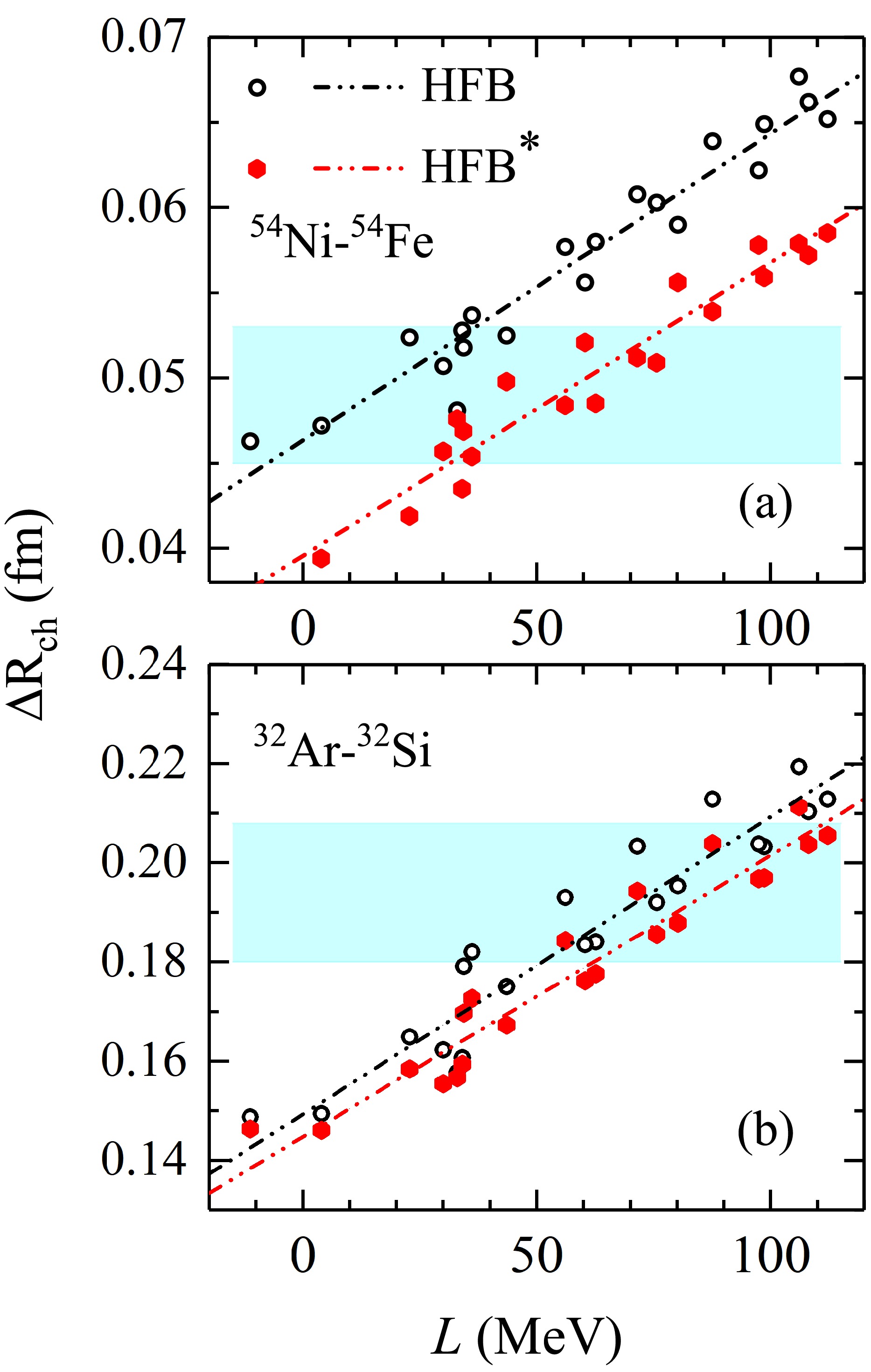
Figure 2. (Color online)
$ \Delta{R_{{\rm{ch}}}} $ of mirror partner nuclei 54Ni-54Fe (a) and 32Ar-32Si (b) obtained by the HFB (open circle) and HFB* (solid pentagon) methods as a function of slope parameter L at saturation density$ \rho_{0} $ . The experimental results are shown as horizontal light blue bands. The dot-dot-dashed lines indicate the corresponding theoretical linear fits.Here, the lower limit of L is constrained at
$ 0.0 $ MeV in our discussion. As shown in Fig. 2 (a), the coved range of L obtained by the HFB model falls into$ 0.0\leq{L}\leq38.11\; (\pm5.07) $ MeV. By contrast, HFB* model gives the range of$ 33.18\leq{L}\leq78.64\; (\pm3.58) $ MeV. This is in accord with Ref. [24] where the deduced L value falls into the range$ 21\leq{L}\leq88 $ MeV. This means that the neutron-proton correlations around the Fermi surface can influence the determination of the values of$ \Delta{R}_{{\rm{ch}}} $ . Moreover, the larger deviation can also be encountered in the mirror pair nuclei 32Ar-32Si. The range of$ 51.22\leq{L}\leq97.87\; (\pm6.17) $ MeV can be extracted from 32Ar-32Si with the HFB method. The HFB* method gives the range of$ 62.21\leq{L}\leq111.59\; (\pm5.19) $ MeV. As demonstrated in Ref. [30], the rather soft equation of state (EoS) has been obtained, namely$ L\leq60 $ MeV. However, a stiffer EoS can be extracted from the charge radii difference of mirror pair nuclei 32Ar-32Si in our calculations. Our results suggest that HFB* model seems to give rather stiff EoS than those obtained by the HFB model. Furthermore, it seems to suggest that the neutron-proton correlations should be considered properly in constraining the slope parameter L. As mentioned in Refs. [43, 44, 82], the quantification uncertainty suffering from nuclear matter incompressibility is inevitable in evaluating the isospin components. As shown in Fig. 2, the influence coming from the nuclear matter incompressibility coefficients cannot be distinguished clearly in discussing the correlation between the charge radii differences of mirror partner nuclei and the slope parameter of symmetry energy. This may lead to the relatively larger uncertainty ranges in evaluating the slope parameter L.To facilitate the quantitative comparison under various incompressibility coefficients, the
$ \Delta{R}_{{\rm{ch}}} $ of 54Ni-54Fe obtained by the HFB and HFB* models is depicted as a function of the slope parameter L shown in Fig. 3. The effective forces classified by various incompressibility coefficients K are used to distinguish the covered range of the slope parameters of symmetry energy. Here it should be mentioned that the covered ranges of the slope parameter L obtained by the HFB method are distinguished evidently from the results obtained by the HFB* model in the mirror-pair nuclei 54Ni-54Fe. For the specific incompressibility coefficients, the covered lower and upper ranges of L are simultaneously enlarged with considering the neutron-proton correlations around the Fermi surface. However, for$ K=230 $ MeV and$ K=240 $ MeV, the covered ranges of L are almost similar for HFB* model. In contrast to$ K=230 $ MeV and$ K=240 $ MeV, HFB* model gives the relatively lower range of L when the effective forces classified by$ K=250 $ MeV are used.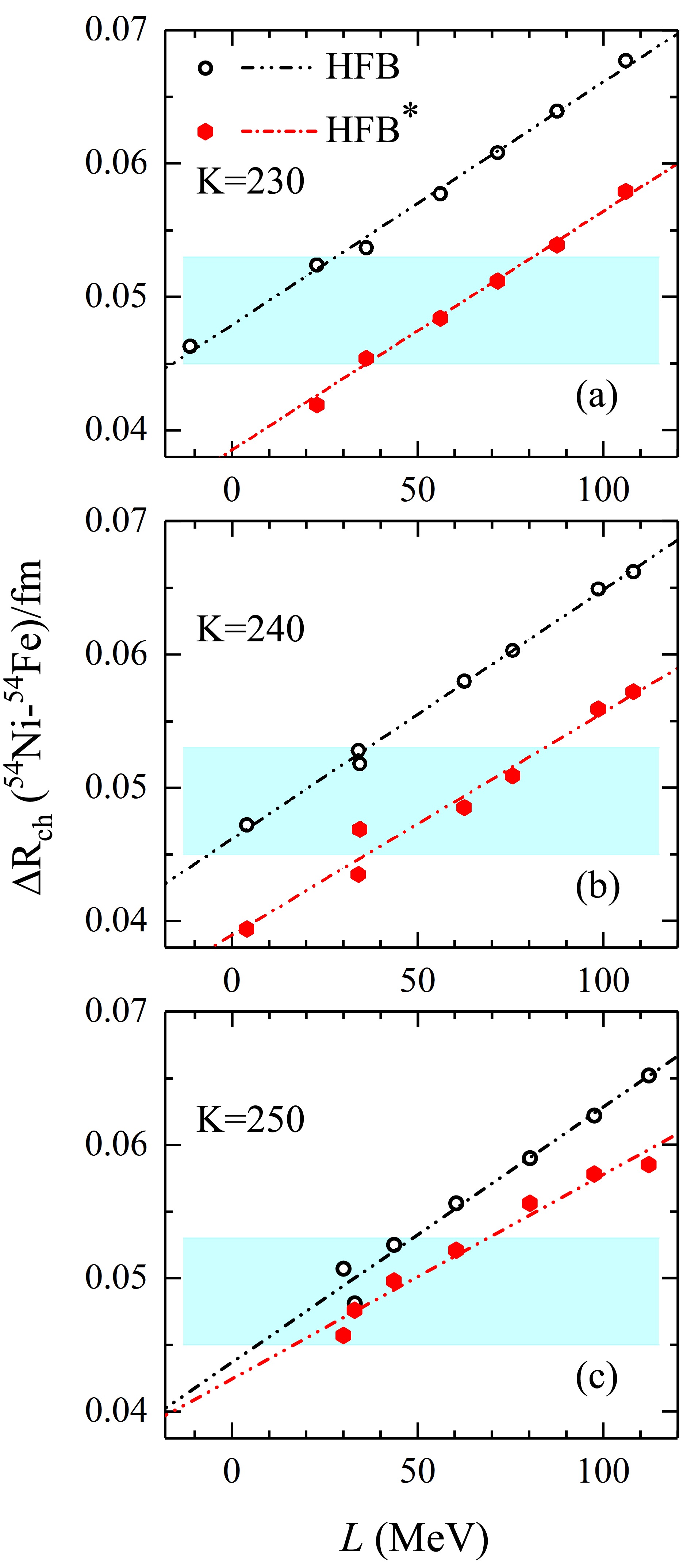
Figure 3. (Color online)
$ \Delta{R}_{{\rm{ch}}} $ of mirror-pair nuclei 54Ni-54Fe as a function of slope parameter L at the saturation density$ \rho_{0} $ . The open circle represents the HFB calculations and the solid pentagon represents the results obtained by HFB* model. The experimental data are depicted as the light blue shadowed band. The dot-dot-dashed line indicates theoretical linear fits.As mentioned above, the incompressibility coefficient has an influence on the determination of the symmetry energy slope. As shown in Fig. 4,
$ \Delta{R}_{{\rm{ch}}} $ of 32Ar-32Si as a function of L is also shown with the HFB and HFB* models. For the parameter set classified by various incompressibility coefficients, the upper and lower limit ranges of the slope parameter L obtained by the HFB* model are systematically enlarged with respect to those obtained by the HFB method. For$ K=240 $ MeV and$ K=250 $ MeV, the covered ranges of L are almost similar for HFB* model. However, for$ K=230 $ MeV case, the upper range of L is more lower than the$ K=240 $ MeV and$ K=250 $ MeV cases, namely about 20 MeV. This further suggests that the correlation between the charge radii difference of mirror partner nuclei and the slope parameter of symmetry energy can be influenced by the effective forces classified by various incompressibility coefficients. In Table 3, the charge radii of mirror partner nuclei 32Ar-32Si and 54Ni-54Fe are shown with various effective forces classified by the incompressibility coefficients$ K\approx230 $ , 240, and 250 MeV.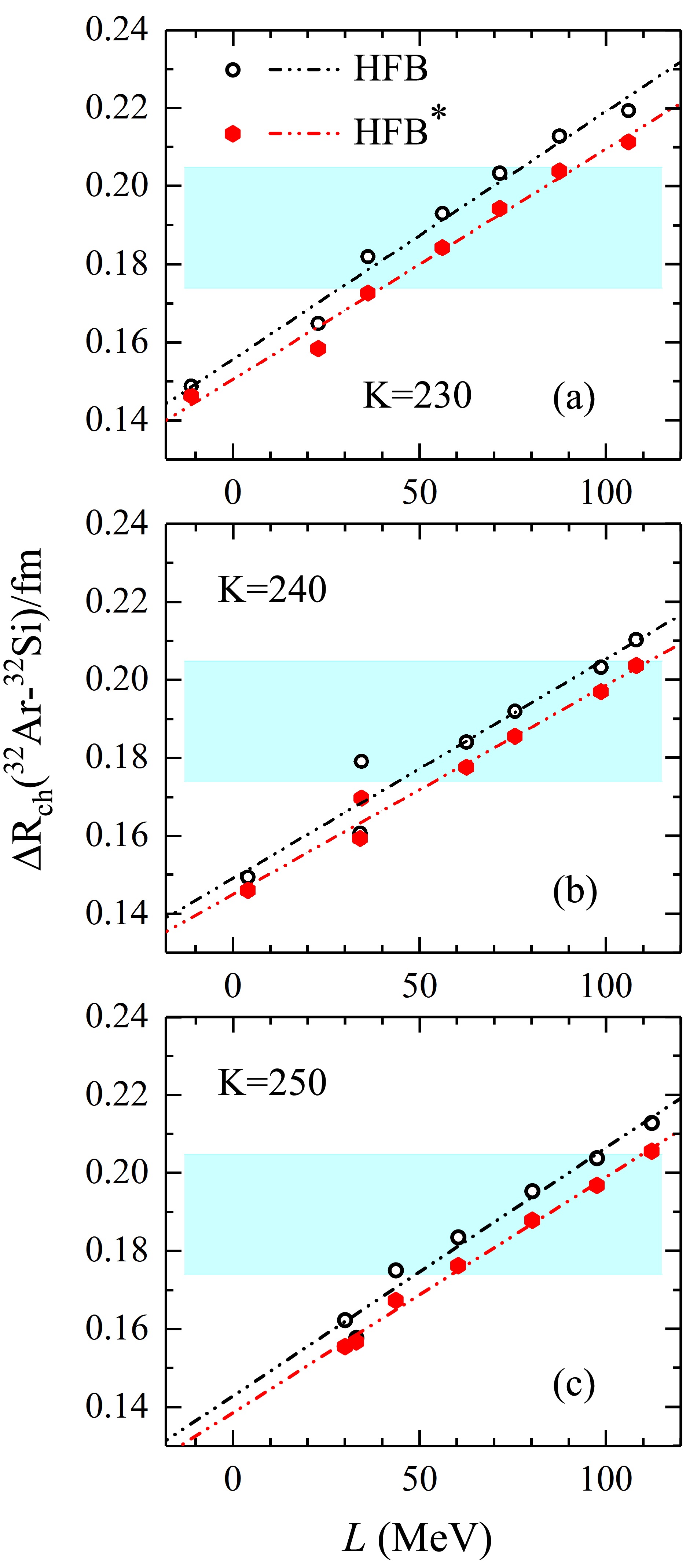
Figure 4. (Color online) Same as Fig. 3 but for mirror-pair nuclei 32Ar-32Si.
HFB HFB* Sets 32Si 32Ar 54Fe 54Ni 32Si 32Ar 54Fe 54Ni $ K\approx230 $ MeV

s3028 3.1984 3.3471 3.7752 3.8215 3.2366 3.3829 3.7856 3.8225 s3030 3.2275 3.3923 3.7893 3.8417 3.2346 3.3930 3.8002 3.8421 s3032 3.2086 3.3906 3.7807 3.8344 3.2327 3.4054 3.7902 3.8356 s3034 3.2101 3.4031 3.7847 3.8424 3.2331 3.4174 3.7945 3.8429 s3036 3.2047 3.4080 3.7830 3.8438 3.2305 3.4248 3.7929 3.8441 s3038 3.2027 3.4155 3.7844 3.8483 3.2298 3.4337 3.7944 3.8483 s3040 3.2070 3.4263 3.7892 3.8569 3.2289 3.4402 3.7998 3.8577 $ K\approx240 $ MeV

s4028 3.2173 3.3667 3.7628 3.8100 3.2222 3.3682 3.7716 3.8110 s4030 3.2590 3.4196 3.7828 3.8356 3.2638 3.4231 3.7921 3.8356 s4032 3.1821 3.3612 3.7325 3.7843 3.2066 3.3763 3.7400 3.7869 s4034 3.1996 3.3836 3.7528 3.8108 3.2078 3.3854 3.7624 3.8109 s4036 3.1938 3.3857 3.7488 3.8091 3.2029 3.3884 3.7585 3.8094 s4038 3.2043 3.4075 3.7641 3.8290 3.2131 3.4101 3.7741 3.8300 s4040 3.1898 3.4001 3.7504 3.8166 3.2012 3.4049 3.7605 3.8177 $ K\approx250 $ MeV

s5028 3.1991 3.3578 3.7298 3.7774 3.2327 3.3893 3.7564 3.8045 s5030 3.2018 3.3640 3.7388 3.7895 3.2110 3.3664 3.7457 3.7914 s5032 3.1988 3.3738 3.7377 3.7902 3.2138 3.3811 3.7435 3.7933 s5034 3.1984 3.3819 3.7402 3.7958 3.2127 3.3889 3.7463 3.7984 s5036 3.2039 3.3992 3.7495 3.8085 3.2198 3.4076 3.7554 3.8110 s5038 3.2040 3.4078 3.7524 3.8146 3.2194 3.4162 3.7587 3.8165 s5040 3.1971 3.4099 3.7218 3.7870 3.2143 3.4198 3.7478 3.8063 Table 3. Charge radii of mirror-pair nuclei 32Ar-32Si and 54Ni-54Fe (in units of fm) are shown with various effective forces classified by the incompressibility coefficients
$ K\approx230 $ , 240, and 250 MeV.Generally, neutron skin thickness of a heavy nucleus provides a superior access to constrain the equation of state of isospin asymmetric nuclear matter. The difference of proton density distributions in mirror nuclei is intimately related to the neutron skin thickness [25, 83]. This indicates that the information about neutron skin thickness can be extracted from the directly measured charge radii data. As demonstrated in Refs. [84, 85], the precise data on mirror charge radii cannot make a rigorous constraint on the slope parameter L, even the worse correlation can be obtained between the mirror charge radii difference
$ \Delta{R}_{{\rm{ch}}} $ and the slope parameter L. The bulk properties of finite nuclei cannot be captured adequately by the effective forces deduced from the infinite nuclear matter. This can be understood from some specific aspects those characterize the radii range of the proton density distributions, such as shell closure effect [11, 86] and the influence coming from isospin symmetry breaking [87–89]. Actually, the proton and neutron matter distributions are mutually influenced by each other. As discussed in this paper, the neutron-proton correlations deduced from the neutron-pairs and proton-pairs condensation around the Fermi surface and the compression modulus have an influence on determining the charge radii difference of mirror nuclei. Therefore, the influence derived from the neutron-proton correlations around the Fermi surface and the compression modulus of symmetry nuclear matter cannot be negligible in describing the nuclear charge radii [43, 55]. -
In this work, the influence of the neutron-pairs condensation around the Fermi surface on the determination of symmetry energy slope is investigated for the first time based on the Skyrme EDFs. The validity of this theoretical model has been reviewed by reproducing the trend of changes of differential charge radii along Ni isotopes. The differential charge radii of Ni isotopes can be described well by this modified model. Especially, the kink phenomenon in charge radii can be significantly reproduced at the neutron number
$ N=28 $ through this modified model. Meanwhile, the shell closure effect at$ N=50 $ can also be expected in the charge radii of Ni isotopes. Intriguingly, the inverted parabolic-like shape in charge radii can be predicted between the neutron numbers$ N=20 $ and$ N=28 $ as well. The same scenario can also be observed between the$ N=28 $ and$ N=50 $ , but the amplitude is apparently weakened.As is well known, nuclear symmetry energy plays an essential role in various simulated codes [90–102]. Therefore, available density dependence of symmetry energy is required from multimessenger constraints. The correlations between the differences of charge radii of mirror partner nuclei 32Ar-32Si and 54Ni-54Fe and the slope parameters of symmetry energy can be affected by the neutron-proton correlations around the Fermi surface and the effective forces classified by various isoscalar incompressibility coefficients. Especially, the rather stiff equation of state can be obtained by the HFB* model in comparison to those deduced from the HFB method. The mean-square charge radius of a nucleus is naturally extracted from the charge density distributions. Recent study suggests that charge radii can be derived from the charge-changing cross section measurements of exotic nuclei [103, 104]. Moreover, the difference of charge-changing cross section of mirror nuclei can also provide an alternative approach to evaluate the equation of state of nuclear matter [105]. Thus a unified model is required in ascertaining the slope parameter of symmetry energy through the charge radii difference of mirror-paired nuclei.
Influence of neutron-pairs condensation on the charge radii difference of mirror nuclei
- Received Date: 2025-02-11
- Available Online: 2025-09-01
Abstract: Highly linear correlation between the charge radii difference of mirror-pair nuclei and the slope parameter of symmetry energy has been built in the existing literatures. In this work, the impact of neutron-proton correlation deduced from the neutron- and proton-pairs condensation around the Fermi surface on determining the slope parameter of nuclear symmetry energy is investigated based on the Skyrme density functionals. The differential charge radii of Ni isotopes are employed to inspect the validity of this recently developed model. The calculated results suggest that the modified model can reproduce the shell quenching of charge radii at the neutron number





 Abstract
Abstract HTML
HTML Reference
Reference Related
Related PDF
PDF
















 DownLoad:
DownLoad:
